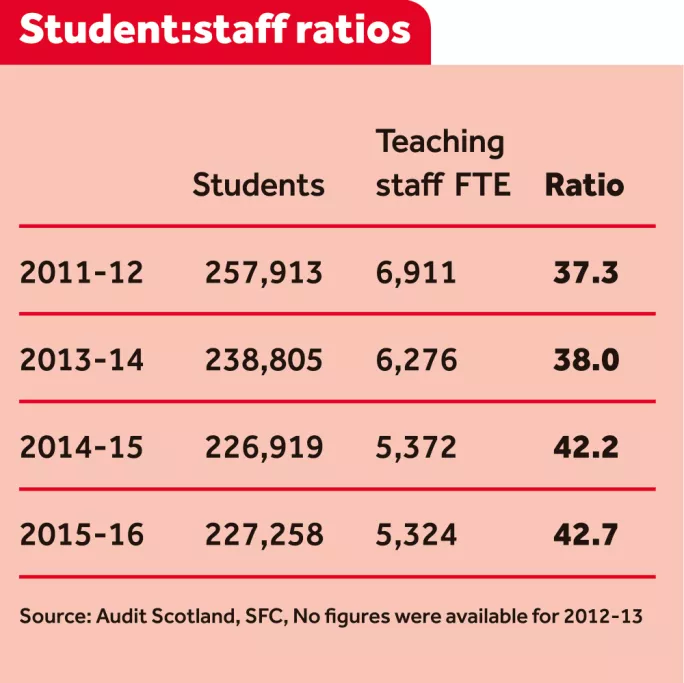Student-to-staff ratio rise is ‘real risk to success’

The number of students per college lecturer has increased by more than 14 per cent since the sector was reformed four years ago, a Tes Scotland analysis reveals.
While on average there were 37.3 students for every full-time member of teaching staff at Scottish colleges in 2011-12 - the year before the college reform process began - that number rose to to 42.7 in 2015-16, the most recent year for which figures exist.
The reform programme saw colleges merged and organised into 13 regions, most of which were left with one large college.
The move coincided with significant cuts to government funding. Teaching staff numbers recorded by the sector went down by more than 1,600, from 6,911 in 2011-12 to 5,324 in 2015-16.
Student headcount also decreased to a lesser extent, from 257,913 to 227,258, according to figures obtained from the Scottish Funding Council.
The analysis appears to confirm anecdotes of larger class sizes in colleges following the government’s cuts to funding - although the student-to-staff ratio varies widely between colleges and courses, and the figures do not include all temporary staff.
Some staff who teach students may not be officially classed as lecturers, and therefore may be excluded from the figures.
While many smaller colleges have large student to staff ratios, others - including a number of those affiliated with the University of Highlands and Islands - have retained a much lower number of students per full-time equivalent teaching staff member.

Even among the large regional colleges, there are significant disparities. At New College Lanarkshire, the ratio has dropped from 39:1 in 2014-15 to 31:1 in 2015-16. But at North East Scotland College, it increased from 56:1 to 63:1.
A spokesman for the EIS teaching union, which represents lecturers, said the cuts of recent years were to blame. He added: “There have been significant cuts to the number of lecturers employed in the further education sector over the past few years, which clearly has an impact on class sizes, lecturer workload and the learning experience for students.”
He said the EIS had resisted college managers’ attempts to impose further changes - affecting preparation and correction time and class contact commitments - which would “inevitably eventually lead to further cuts to lecturer numbers, ever-soaring workload and damage to the learning experience of students”.
Rob Henthorn, NUS Scotland’s vice-president for education, said: “These figures come four years after college mergers - a process designed to create a more efficient college sector, and which could have realised huge benefits for students.
“But efficiency can never be driven purely by a financial bottom line, or a squeeze on teaching and support staff, or the support that students receive. That absolutely relies on having the staff in place to deliver on those ambitions and ensure the necessary support for those students.
“Overcrowded classes, and staff that simply do not have the time or opportunity to provide the high quality learning environment they want, poses a real risk to the continued success of our colleges.”
A spokesman for Dundee and Angus College, where the ratio increased from 43 students per teacher to 58, warned that the figures could be open to misinterpretation.
He said much of the change was due to “a reduction in academic and other management posts through the coming together of two management structures into a single and efficient structure” for the merged college.
A North East Scotland College spokeswoman said it was committed to delivering the best student experience with the most efficient use of public resources possible. She added: “The figures are most likely due to increased student numbers as overall teaching staff numbers have not reduced.
“We are confident that the high-quality learning experience at NESCol is not negatively impacted by this small increase.” Published data showed a significant increase in the numbers of students succeeding on both FE and HE programmes over the years in question.
Shona Struthers, chief executive of Colleges Scotland, said colleges delivered courses across a wide range of subject areas to meet the needs of a diverse range of learner and business needs, and class size would vary depending on specific teaching requirements.
“For example, a practical-based course such as joinery is likely to have smaller class sizes due to health and safety requirements and the equipment involved, rather than a theory-based course such as psychology,” she said.
“The numbers of teaching staff required will depend on the courses being delivered. As well as lecturing staff, colleges also have tutors and technicians who provide in-class support to enhance the delivery of learning and teaching.”
You need a Tes subscription to read this article
Subscribe now to read this article and get other subscriber-only content:
- Unlimited access to all Tes magazine content
- Exclusive subscriber-only stories
- Award-winning email newsletters
Already a subscriber? Log in
You need a subscription to read this article
Subscribe now to read this article and get other subscriber-only content, including:
- Unlimited access to all Tes magazine content
- Exclusive subscriber-only stories
- Award-winning email newsletters